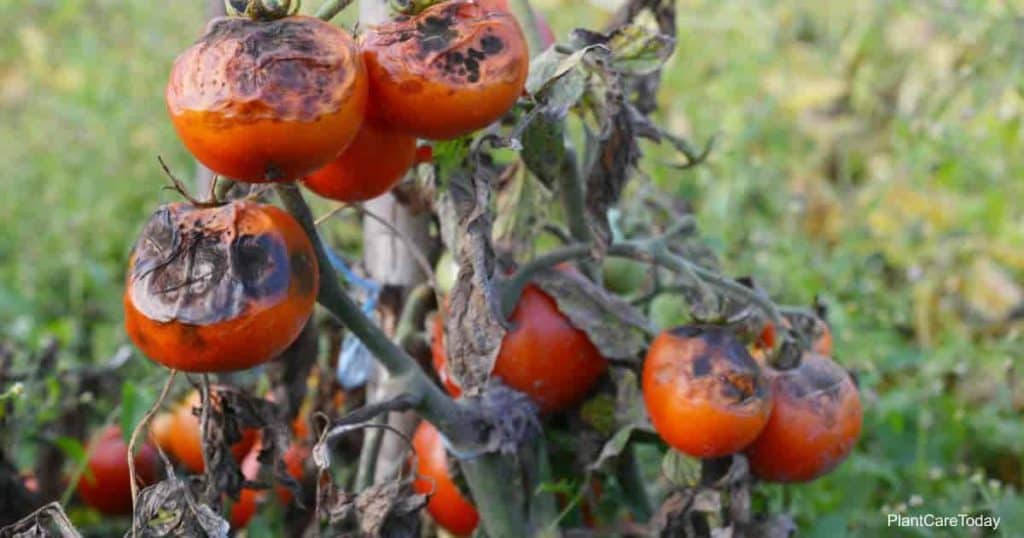Anyone who grows tomato plants will know how quickly tomato blight, a bacterial disease, can destroy plants in the garden.
It can be challenging to treat infected plants with multiple tomato blight types, such as fire blight and tip blight, once the infection has set in.

The cause of early tomato blight comes from two different fungal diseases. The first attacks the oldest leaves but soon spreads to the stems and eventually the fruit.
It quickly kills seedlings but can also destroy full-grown varieties of tomatoes if not treated quickly.
Meanwhile, late blight is a fast and deadly mold. It first resembles water spots but quickly rots the leaves and stems as it spreads. It even manages to grow on infected tomatoes that are improperly stored.
In this article, we’ll provide an in-depth look at using neem oil for blight.
Neem Oil Benefits
Anyone who’s used neem oil to combat plant problems in the past knows it has a lot of benefits.
It can be used as a natural fungicide to kill fungal and bacterial diseases such as anthracnose, black spot, blight, botrytis, fire blight, powdery mildew, rust, and scab.
It also acts as a natural pesticide that will save your vegetables from aphids, grubs, thrips, spider mites, mealybugs, whiteflies, Japanese beetles larvae, leafrollers, caterpillars, and other insect pests.
Because neem oil targets insects that chew on leaves, they are considered safe for use around butterflies, ladybugs, pollinators bees, and many other beneficial insects.
With these benefits from neem oil, you might be encouraged to try it out on blight disease development on tomatoes, but will it work against some or all forms of leaf blight?
Does neem oil work on tomato blight?
Does Neem Oil Kill Blight?
The sad news is that neem oil for tomato blight is not enough on its own.
However, the good news is that you can use neem oil for early blight and late tomato blight treatment, and it may even kill the blight in its earliest stages of infection and can be used until the day of harvest.
Related: Can You Use Neem Oil On Tomato Plants?
How Neem Oil Mixture Prevents Infections
When used as a preventative, neem foliar sprays can often kill fungal spores that have landed on the plant’s surface.
Soil soaks, or drenches can trigger an immune response to fight off an infection that breaks through the plant’s surface.
Both remedies require one tablespoon of pure castile soap per gallon of water to act as an emulsifier.
Neem soil soaks include two tablespoons of 100% percent cold-pressed raw neem oil, while the foliar spray uses four tablespoons of clarified hydrophobic neem oil.
Application instructions: Pour 2 to 4 cups of your soil soak over the roots, which will then absorb the primary active chemical, Azadirachtin, turning it into a systemic insecticide for up to 22 days.
It won’t affect surface infections, but the Azadirachtin will attack fungal infections once they break the plant’s surface.
Meanwhile, thoroughly soaking every part of the plant with the foliar spray at both dusk and dawn will allow it to attack the surface fungus, although the oil will only last for up to an hour.
Does Neem Oil Treat Blight Infection?
The active element of raw neem oil, Azadirachtin, isn’t present in clarified neem oil and is the most potent of the five active chemicals.
The raw oil’s ability to jumpstart the plant’s immune response allows the plant to fight off the infection but doesn’t harm the fungus itself.
Meanwhile, the clarified oil can kill some surface spores but cannot kill an established infection that has expanded under the plant’s surface.
As infection spreads, the tomato blight neem oil’s benefits become less effective, and it becomes necessary to bring in more potent chemicals.
However, the qualities that make neem oil highly effective against a handful of fungi may sometimes prove just enough to stop disease pressure, when it first infects the plant.